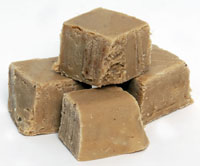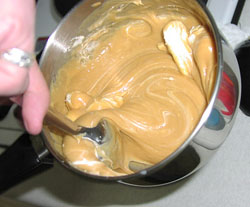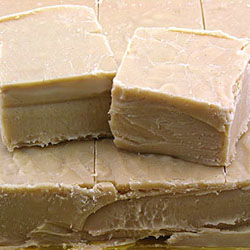 There's no better time of year to bless the ties that bind. Holidays are about traditions, and the very definition of tradition is "an inherited or customary pattern of thought, belief or action" --- those ideas and rituals, large and small, passed on from generation to generation.
There's no better time of year to bless the ties that bind. Holidays are about traditions, and the very definition of tradition is "an inherited or customary pattern of thought, belief or action" --- those ideas and rituals, large and small, passed on from generation to generation.
For me, it just isn't Christmas without one good carol singing (in Atlanta, I like to go to jazz vespers at First Congregational Church downtown in early December), without my pink rabbit's foot dangling from a lower branch on my tree and without Mammaw's peanut butter fudge.
In fact, now that my grandmother is gone, I'm the sole torchbearer in my family for this ultrasweet and buttery confection that's made the very old-fashioned way — that is to say, without "foolproof" marshmallow cream or any other shortcut. My brothers absolutely expect me to arrive in Kentucky with several batches in hand. If I don't, I spend part of my visit at the stove.
Each December, when I pull out that faded and stained recipe, I feel the binding tie tug tightly as I run my fingers over the words written by my grandmother's hand on a now fragile piece of notepaper, quite like the catch in my throat I get when I unwrap the burlap and cardboard angel
ornament I've had since I was 6.
 But to fully honor Mammaw in the experience, I must struggle in the making. She did. Every year. The recipe is so deceptively simple. Mix butter, sugar, peanut butter and buttermilk in a saucepan and stir over medium heat until done. The "done" part, of course, is what's tricky. There's a reason folks came up with "foolproof" fudge recipes. And this is it — done is darn hard to figure out when it comes to candy.
But to fully honor Mammaw in the experience, I must struggle in the making. She did. Every year. The recipe is so deceptively simple. Mix butter, sugar, peanut butter and buttermilk in a saucepan and stir over medium heat until done. The "done" part, of course, is what's tricky. There's a reason folks came up with "foolproof" fudge recipes. And this is it — done is darn hard to figure out when it comes to candy.
I flubbed my very first batch this year, which prompted a gaze toward the heavens. "Mammaw, do you see this?" I said as I tilted the pan and watched the tarlike blob shift and slide. I remembered her valiant efforts to save such a batch. She would try freezing it. She'd try reheating it and cooking some more. I knew from her experience, it was no use. I scraped the goo into the garbage can.
 It is my practice to use two methods to test the concoction for doneness. Mammaw's way — dropping a small amount into a cup of cold water and trying to form a ball. And the modern way — relying on a candy thermometer to tell me when the mixture has reached 240 degrees (the "soft
It is my practice to use two methods to test the concoction for doneness. Mammaw's way — dropping a small amount into a cup of cold water and trying to form a ball. And the modern way — relying on a candy thermometer to tell me when the mixture has reached 240 degrees (the "soft
ball" stage). It took 30 minutes that first night to get to 240 degrees and to form a soft ball. Still, I knew within minutes of pouring the mixture into the buttered pan that it was undercooked and wasn't going to set up.
So I tried again the next night. This time, I cooked the fudge a little faster (and stirred more vigorously), reaching 240 degrees in little more than 20 minutes. I decided to keep the pan over the flame even longer. When I could form a stiff ball and the thermometer read nearly 250 degrees, I saw brown bits beginning to surface.
I knew from watching Mammaw all those times, that I was headed to the opposite disaster — candy too scorched and brittle to enjoy. I swiftly picked the pot up, spiked it with vanilla, beat the mixture a few times to work out the air bubbles and poured. I knew by the way the candy hardened
on the spoon that I had found the magic.
Mammaw used to swear that "the magic" must have something to do with "the way you hold your mouth while stirring" or some such random factor. I suppose, dear readers, if I were really your friend I would fully investigate the rules of fudge making to offer a clear, even "foolproof" method for making this recipe. I realize because I didn't, some of you will not try it, which means you'll miss out on the most divinely sweet treat Santa could ever hope for.
But I cannot do that. It is tradition in my family to flub the fudge. Failure makes it all that much sweeter.
 Peanut Butter Fudge
Peanut Butter Fudge
Butter a 9-inch cake pan and set aside. In a medium-size heavy saucepan, combine ½ cup butter (1 stick), 2 cups sugar, 2/3 cup buttermilk and 4 tablespoons creamy peanut butter.
Over a medium flame, mix the ingredients as the butter melts. Continue cooking, stirring frequently, until the mixture reaches between 240 and 250°F on a candy thermometer or until you can form a stiff, but not hard, ball when a teaspoon of the mixture is dropped into a cup of cold water.
This will take 20 to 30 minutes, depending on, perhaps, how you hold your mouth while stirring.
Once the mixture is ready, remove from heat and add 1 teaspoon vanilla and beat the mixture until most of the air bubbles are gone and there's a nice gloss. Pour into pan and let rest for 30 minutes.
But you'll know in about 10 minutes if you found the magic, as the mixture should set up by then.
Makes about 20 pieces of fudge.
My first mother-in-law couldn't cook. Mamaw, as my children called her in the Southern tradition, turned the heat on under the pan until the kitchen was full of smoke, then she turned the heat off, rendering what was in the pan charred and raw at the same time, not an easy feat.
Mamaw also hated me for many things, not the best situation for a teen age bride like I was. One of reasons she couldn't stand me was my cooking skills. Another was the fact that I was a Yankee and a Presbyterian, both negatives in Mamaw's eyes. But even a heathen Yankee like me could appreciate her peanut butter fudge.
She only made it at Christmas. And she never shared her recipe or method with me, enjoying her one moment of culinary superiority of the year. But she did share her methods with my daughter, and now I'm sharing her story with you. -- Lou Jane Temple
Originally published in the Atlanta Journal-Constitution

